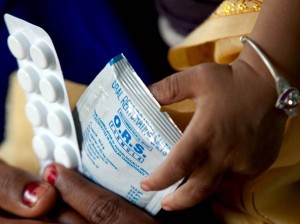About ORS and Zinc
ORS and zinc prevent a majority of diarrheal deaths and cost less than US$ 0.50 per treatment course. Together, they significantly reduce the duration and severity of diarrheal episodes.
Globally, 2.5 million cases of diarrhea occur in children every year, and children 24 months or younger are at the greatest risk of death from diarrheal disease[1]. Diarrheal diseases cause approximately 11% of deaths among children under five worldwide, or 0.7 million deaths in 2011, mostly in developing countries. More than half of these deaths occur in just four countries: India, Nigeria, the Democratic Republic of the Congo and Pakistan[2].
 Commodity Context
Commodity Context
The World Health Organization (WHO) recommended treatment for diarrhea is oral rehydration salts (ORS) and zinc, products that are highly effective and affordable. WHO specifically recommends low-osmolarity ORS (L-ORS) with reduced glucose and salt concentration in solution as it prevents possible adverse effects of hypertonicity on net fluid absorption[3]. Recent studies suggest that administration of zinc along with L-ORS can reduce the duration and severity of diarrheal episodes for up to three months[4].
Despite the existence of these simple, life-saving treatments and the low cost of the treatments, many children with diarrhea are not receiving these products in developing countries: only 38% of children receive ORS and less than 5% receive zinc[5]. ORS and zinc coverage remains particularly insufficient among the most vulnerable populations: rural, lower income people. Research and pilot programs have demonstrated success in scaling up ORS and zinc, but have primarily been small-scale. Additional attention and investment in comprehensive and ambitious programs can significantly scale up access to these simple, low-risk products and is essential to accelerating progress to Millennium Development Goal 4 of reducing child mortality by two-thirds by 2015.
Products Available
ORS is on the WHO model list of essential medicines as well as EMLs in most countries[6]. It is manufactured in many countries and is commonly available without a medical prescription. There are 55 manufacturers of zinc products on the Zinc Task Force supply list, but not all meet standards required for international tenders. The majority of manufacturers are in South Asia.
Product Efficacy
A systematic review on studies evaluating efficacy of ORS estimated that it may prevent 93% of diarrhea deaths [8]. A similar systematic review on efficacy of zinc found that zinc supplementation decreased the proportion of diarrheal episodes that lasted beyond seven days, risk of hospitalization, all-cause mortality and diarrhea mortality. The review estimated that zinc decreases diarrhea mortality by 23% and has the potential to significantly decrease diarrhea morbidity and mortality when introduced and scaled-up in low-income countries[9].
Common Barriers
Suboptimal products like antibiotics and anti-diarrheals continue to be used and often preferred by caregivers and providers alike. Though much more effective than antibiotics, ORS and zinc do not provide immediate relief of symptoms and may be negatively perceived by caregivers. Also, in its powder form, ORS must be mixed with water, thus the water quality needs to be ensured in order for appropriate administration. In addition, when taken with ORS, the treatment dose required for zinc is 10-14 days compared to ORS treatment for only the first few days, increasing the chances for incorrect use.
For more information on ORS and zinc, please visit the UN Every Woman Every Child initiative ORS webpage and Zinc webpage.
[1] (WHO), The United Nations Children’s Fund (UNICEF)/World Health Organization. (2009). Diarrhoea: Why children are still dying and what can be done.
[2] UNICEF. (2012). Reanalysis based on CHERG, IGME, 2012. Pneumonia and Diarrhoea: Tackling the deadliest diseases for the world's poorest children New York.
[3] WHO. (2006). Oral Rehydration Salts: Production of the New ORS.
[4] Bajait, Chaitali, & Thawani, Vijay. (2011). Role of zinc in pediatric diarrhea. Indian journal of pharmacology, 43(3), 232.
[5] Black, Robert E, Cousens, Simon, Johnson, Hope L, Lawn, Joy E, Rudan, Igor, Bassani, Diego G, . . . Cibulskis, Richard. (2010). Global, regional, and national causes of child mortality in 2008: a systematic analysis. The Lancet, 375(9730), 1969-1987.
[6] Organization, World Health. (2010). WHO model list of essential medicines: 16th list (updated) March 2010.
[7] Zwisler, Greg, Simpson, Evan, & Moodley, Melissa. (2013). Treatment of diarrhea in young children: results from surveys on the perception and use of oral rehydration solutions, antibiotics, and other therapies in India and Kenya. Journal of global health, 3(1).
[8] Munos, Melinda K, Walker, Christa L Fischer, & Black, Robert E. (2010). The effect of oral rehydration solution and recommended home fluids on diarrhoea mortality. International journal of epidemiology, 39(suppl 1), i75-i87.
[9] Walker, Christa L Fischer, & Black, Robert E. (2010). Zinc for the treatment of diarrhoea: effect on diarrhoea morbidity, mortality and incidence of future episodes. International journal of epidemiology, 39(suppl 1), i63-i69.
